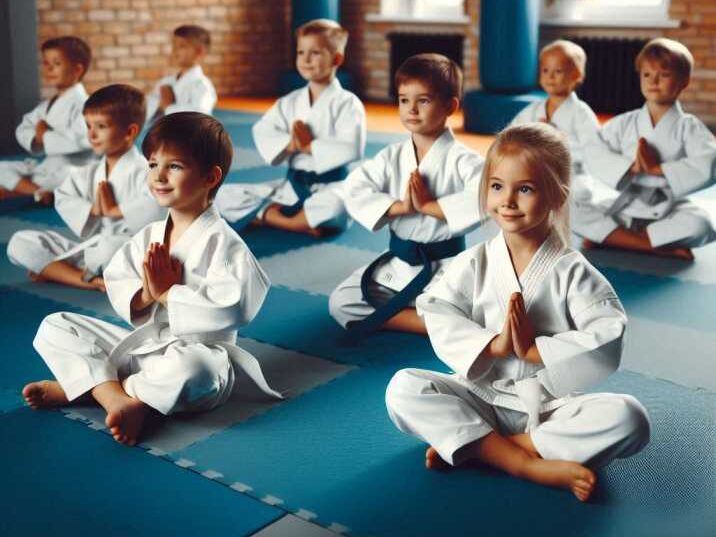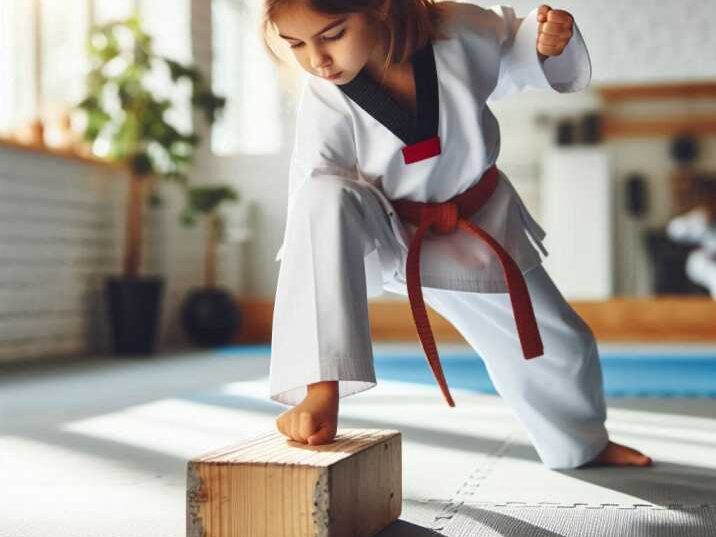Introduction
Table of Contents
Martial arts isn’t just about learning kicks, punches, and fancy moves. It’s about building a strong foundation of discipline, focus, and confidence, especially for young children. For 5 year olds, martial arts can be the perfect activity to help them grow both mentally and physically. But why is martial arts such a great choice for kids at this age? And what can parents expect from enrolling their children in a martial arts class? This article dives into the exciting world of martial arts for kids, focusing on the benefits it offers 5-year-olds and how it shapes their overall development.

Why Martial Arts for 5 Year Olds?
1. Building Confidence and Self-Esteem
Children around the age of 5 are just beginning to explore the world on their own terms. Martial arts helps them develop a sense of confidence in their abilities by mastering new skills. Every time they learn a new move or earn a belt, they feel proud of their achievements. This boost in self-esteem is crucial at this young age, helping them believe in themselves both in and out of class.
2. Developing Focus and Concentration
Martial arts training requires kids to listen carefully to instructions and practice moves repeatedly. This helps them improve their focus and concentration, which can directly impact their performance in school. Many parents notice that children who practice martial arts tend to be more attentive in class and better at completing tasks without getting easily distracted.
3. Teaching Discipline and Respect
Respect for instructors, fellow students, and themselves is a core part of martial arts training. At 5 years old, learning discipline is crucial for long-term personal development. Children are taught to follow rules, be polite, and show kindness to others, both on and off the mat.
4. Improving Physical Fitness
Martial arts helps 5-year-olds stay active in a fun and engaging way. Whether it’s karate, taekwondo, or Brazilian Jiu-Jitsu, the physical activity strengthens their muscles, improves flexibility, and boosts their endurance. For kids who love to run and play, martial arts offers an exciting way to stay healthy and burn off energy.
5. Improves Social Skills
Martial arts classes are often conducted in group settings, which helps kids learn to interact with their peers, instructors, and other adults. This social interaction enhances their ability to communicate, share, and cooperate.
- Teaches teamwork: Even though martial arts is often thought of as an individual sport, many exercises require students to work in pairs or groups, which helps kids learn teamwork and collaboration.
- Builds friendships: Practicing with the same group of students regularly helps young kids form bonds and build friendships in a structured environment.
6. Increases Self-Discipline and Responsibility
Martial arts is more than just physical movements; it teaches self-discipline by requiring students to practice regularly and adhere to rules. Instructors often emphasize the importance of being responsible for their training gear, attending classes on time, and following instructions carefully.
- Promotes self-discipline: Children learn to control their impulses and follow through with commitments, which can also be beneficial in their schoolwork and at home.
- Encourages responsibility: Having to care for their uniform, belts, and other gear teaches them the value of responsibility from an early age.
7. Promotes Better Physical Health
Martial arts is an excellent way to keep kids active, which is important in today’s digital world where screen time is prevalent. The physical activity involved in martial arts improves cardiovascular health, builds strength, and keeps children fit.
- Improves overall fitness: Martial arts offers full-body exercise, including aerobic and anaerobic workouts, helping children stay fit and maintain a healthy weight.
- Boosts immune system: Regular physical activity can help improve the immune system, which can reduce the chances of illness.
Popular Martial Arts for 5 Year Olds
1. Karate
Karate is highly recommended for young children because it introduces them to martial arts in a structured and supportive environment.
- Boosts discipline and focus: Karate emphasizes following instructions, paying attention to the instructor, and repeating movements until they’re mastered. This process naturally improves a child’s ability to concentrate, which also helps in school and other activities.
- Enhances balance and agility: Karate involves learning a variety of stances, kicks, and punches. These movements help improve a child’s balance and agility, building physical coordination that can carry over to other sports and daily activities.
- Teaches respect for others: One of the core values in karate is showing respect to your instructors, classmates, and even your opponents. Bowing before and after a class or sparring match is a sign of respect, which helps children understand the importance of courtesy and humility.
2. Taekwondo
Taekwondo is known for its fast, high-energy techniques, making it particularly exciting for younger kids.

- Builds self-confidence: Taekwondo has a structured belt system that allows kids to set goals and achieve them step by step. Every time a child earns a new belt or learns a new technique, it builds their confidence and self-belief.
- Teaches goal-setting through belt systems: The belt progression system in Taekwondo is a great way for children to learn about setting goals. Each belt represents a new milestone, teaching them that with hard work and perseverance, they can achieve great things.
- Improves focus and agility: Taekwondo’s fast kicks and dynamic movements help develop a child’s physical agility. At the same time, the need to listen and follow instructions in a class improves their ability to focus on tasks.
3. Brazilian Jiu-Jitsu (BJJ)
Brazilian Jiu-Jitsu (BJJ) is unique because it focuses on grappling rather than striking. It is especially effective for teaching children how to defend themselves through technique and strategy.
- Enhances problem-solving skills: BJJ is like a physical chess match. Kids must think about how to counter their opponent’s moves and find a way to gain control. This approach helps them develop strong problem-solving skills and strategic thinking, which can also benefit them in academic environments.
- Teaches self-defense and control: Unlike other martial arts that focus on striking, BJJ teaches kids how to control an opponent without causing harm. This helps young children understand the importance of restraint and when it’s appropriate to use force, promoting responsible behavior.
- Improves physical strength and coordination: BJJ requires a lot of grappling, rolling, and ground control. These movements build muscle strength, especially in the core and legs, while improving coordination and body awareness.
4. Kung Fu
Kung Fu is one of the oldest martial arts and is great for kids because of its emphasis on both mental and physical development.
- Improves coordination and balance: Kung Fu features fluid, animal-inspired movements that require excellent coordination and balance. For young children, these fun and imaginative movements help improve their overall physical coordination, making them more agile and balanced in everyday activities.
- Enhances flexibility and body awareness: Kung Fu involves stretching and dynamic movements that help children improve their flexibility. Developing body awareness at an early age helps children gain better control over their movements, reducing the likelihood of injury in other sports or play.
- Teaches patience and perseverance: Learning the complex movements of Kung Fu can take time, which teaches children the value of patience. They learn that mastering any skill requires dedication and persistence, which are valuable life lessons.
5. Judo
Judo focuses on grappling, throws, and ground control, similar to BJJ, but also teaches kids how to fall safely and control their opponents without inflicting harm.
- Builds strength and agility: Judo involves learning how to throw opponents and control them on the ground. These techniques help develop physical strength, particularly in the arms, legs, and core, while also improving a child’s agility as they learn to move swiftly and efficiently.
- Teaches control and self-defense: A key aspect of Judo is learning how to subdue an opponent without hurting them. This helps children understand the importance of self-control and using their skills responsibly, promoting non-aggressive self-defense.
- Encourages teamwork and mutual respect: In Judo, children often work in pairs to practice throws and techniques. This helps them develop teamwork skills and mutual respect for their training partners, creating a positive and cooperative learning environment.
How Martial Arts Affects School Performance
Many parents find that enrolling their child in martial arts leads to noticeable improvements in school performance. Training helps children develop focus, improves their ability to follow instructions, and teaches the importance of goal-setting and perseverance. The skills they learn in martial arts directly translate to better concentration and behavior in school.
Safety Considerations for Young Martial Artists
While martial arts is generally safe for children, it’s important for parents to choose a reputable school with certified instructors. Look for classes specifically designed for young children, where safety precautions are a priority. Protective gear like headgear, gloves, and shin guards can also help prevent injuries, ensuring that your child stays safe while having fun.
Table of Information
| Martial Art Type | Recommended for 5-Year-Olds? | Focus Areas | Typical Class Length |
|---|---|---|---|
| Karate | Yes | Discipline, Respect | 30-45 minutes |
| Taekwondo | Yes | Focus, Confidence | 30-45 minutes |
| Brazilian Jiu-Jitsu (BJJ) | Yes | Problem-Solving, Strategy | 30-45 minutes |
| Kung Fu | Yes | Coordination, Balance | 30-45 minutes |
| Judo | Yes | Strength, Self-Control | 30-45 minutes |
Conclusion
Introducing your 5-year-old to martial arts is one of the best decisions you can make for their development. From improving their focus in school to building their confidence and teaching discipline, martial arts offers a well-rounded approach to both physical and mental growth. Whether it’s karate, taekwondo, or judo, martial arts helps children develop skills that last a lifetime.
FAQs About Martial Arts for 5 Year Olds
1. What is the best martial art for a 5-year-old?
Karate and Taekwondo are often recommended for young children because they focus on discipline, coordination, and respect.
2. How often should a 5-year-old practice martial arts?
Typically, two to three times a week is ideal for 5-year-olds to balance learning and fun without overwhelming them.
3. Can martial arts help with behavior problems?
Yes, martial arts can improve behavior by teaching discipline, respect, and self-control.
4. Are martial arts classes safe for young children?
Yes, as long as classes are led by certified instructors and appropriate safety gear is used.
5. Will martial arts improve my child’s focus in school?
Yes, many children who practice martial arts show improved focus and concentration in school.


